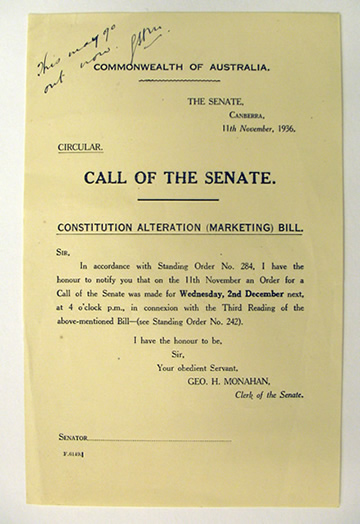106 Notice of order
A notice for an order for a roll call of the Senate, as soon as practicable after the notice is given, shall be forwarded by the Clerk to each senator.
Amendment history
Adopted: 19 August 1903 as SO 276 but renumbered as SO 272 for the first printed edition
Amended:
- 11 June 1914. J.79–80 (to allow notice to be delivered by hand as well as by post)
- 1 September 1937 J.44 (to take effect 1 October 1937) (replaced “post” with “letter or telegram”)
1989 revision: Old SO 284 renumbered as SO 106; prescriptive provisions on the mode and method of forwarding a notice removed
Commentary

Notive of an order for a roll call, formerly known as a call of the Senate
Originally known as a call of the Senate, a roll call is not a method of voting but a means of summoning senators to the chamber when an important matter is to be voted on, and of calling the roll to ascertain whether all senators are present. Its rationale is to provide for delay in these circumstances to ensure careful consideration of the matter in question. A roll call is required immediately before the third reading of a bill to alter the Constitution unless the requirement to do so is suspended. See the illustration for an example of a notice for an order for a roll call.
In contrast to its limited use in the Australian Senate, roll calls are used for all recorded voting in the United States Senate with each senator indicating his or her vote when their names are called. The names of senators who are not present initially are called again at the end of the list. The procedure had been so rarely used in Australia and was so frequently suspended that it was suggested for deletion in the 1989 revision. A rare recent use had demonstrated, in any case, that because the order could be made in advance, it did not necessarily provide the safeguard of delay.[1]
The procedures were retained in the revised standing orders at the request of senators but were renamed as “roll call” rather than “call of the Senate”. The provisions for a roll call for any purpose and the requirement for a roll call before the third reading of a Constitution alteration bill were also grouped together in the same chapter.[2]
Amendments made before 1989 are of historical interest only in that they related to the mode of delivery of a notice for a roll call. All such prescriptive material was removed in the 1989 revision in any case. If a roll call were to be ordered today, notice of it would no doubt be provided to senators by email.